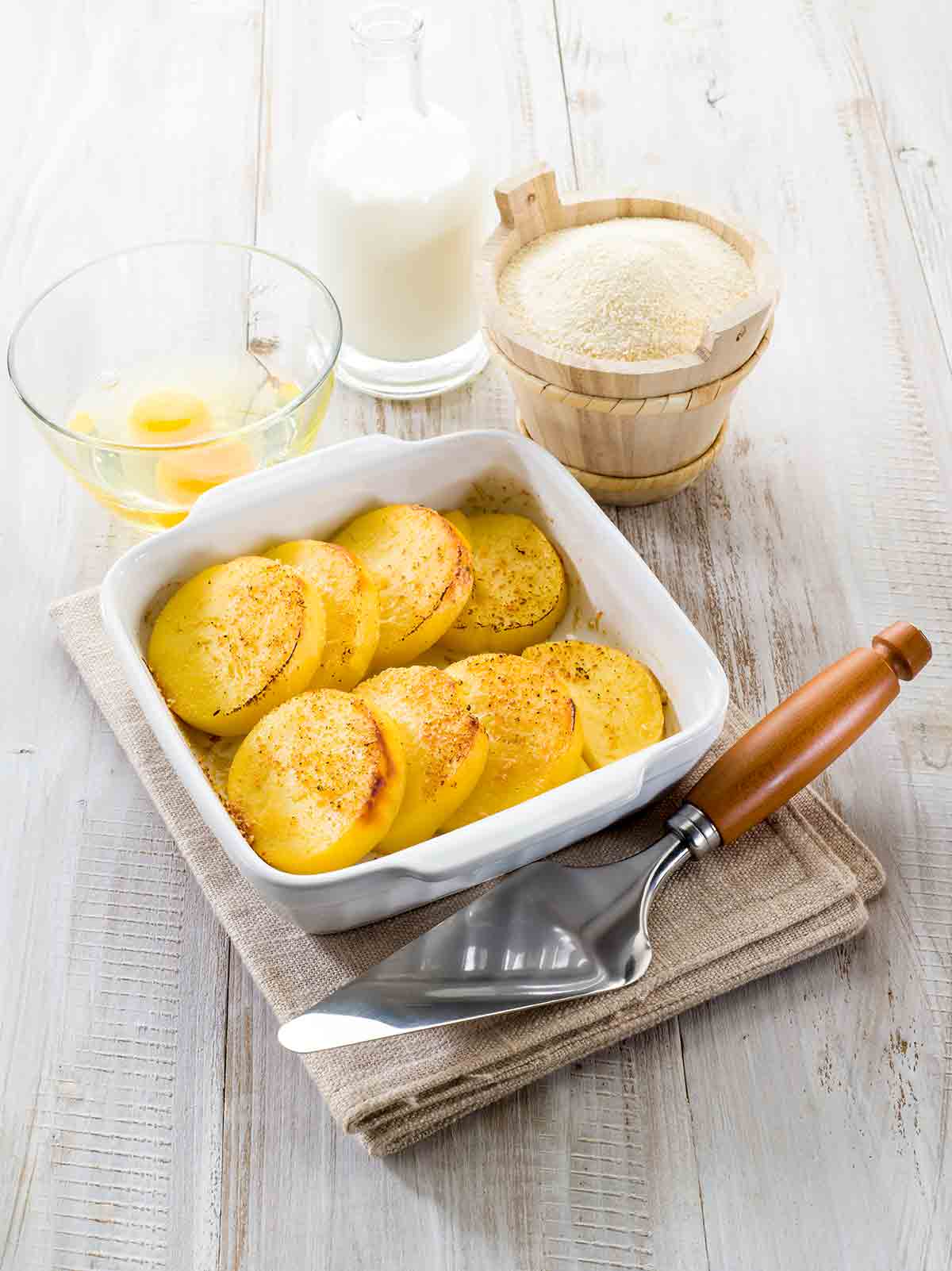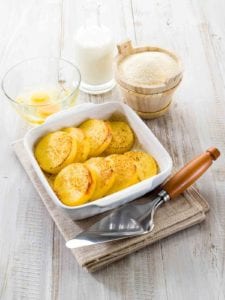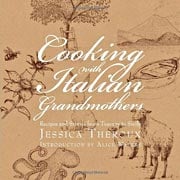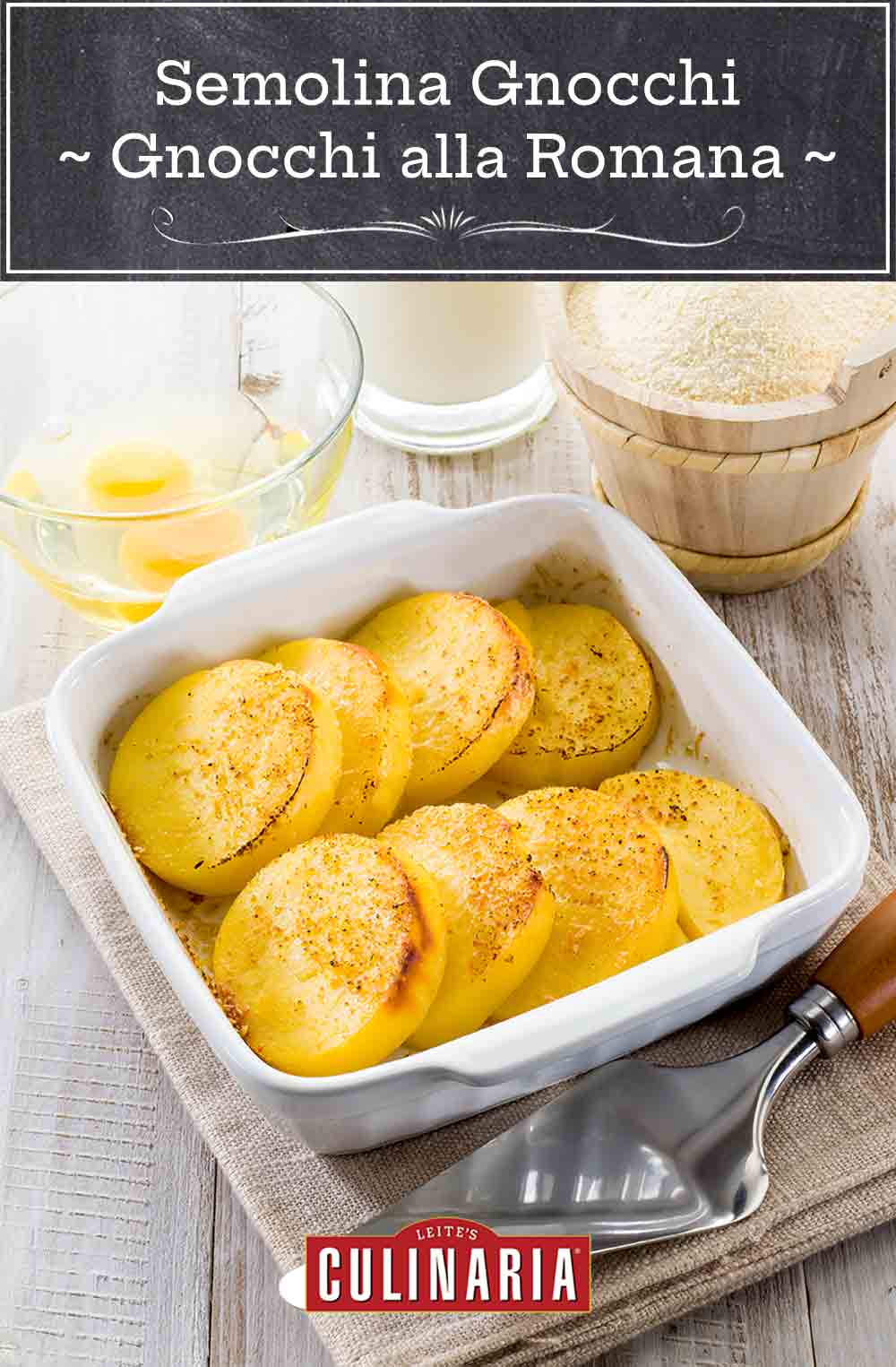
To form the gnocchi, a rich polenta-like paste is prepared, cooled, and then cut into disks using the wet rim of a small glass. The disks are then sprinkled with Parmesan and bread crumbs, and baked in a hot oven to puff them up.–Jessica Theroux
LC Gnot Your Gnormal Gnocchi Note
Nope. No potatoes or fork tines or tiny little pillows smothered in gorgonzola cream sauce in sight. And that’s not a terrible thing, not when you consider how light and airy this intriguing approach to gnocchi can be. Still, they’re quite indulgent, much more a starter or a side than a centerpiece to a meal. So indulgent that we think you, like us, won’t want to waste a single scrap of dough.
This calls to mind Marcella Hazan‘s tactic for dealing with gnocchi trimmings in Essentials of Classic Italian Cooking. Just knead the trimmings together into a ball (you can wrap and refrigerate the trimmings for up to a day or two). Then pinch off croquette-size pieces and shape them into short, plump forms that are tapered at both ends, about 2 1/2 inches in length. Roll the forms in dry, unflavored bread crumbs and fry them in hot vegetable oil until they take on a light, golden crust. Sounds lovely, yes? And that’s just the trimmings. Wait until you try the actual gnocchi…–Renee Schettler
WHAT IS THE DIFFERENCE BETWEEN SEMOLINA AND POLENTA?
These little disks of goodness are made from semolina–which is wheat flour. Polenta is made from cornmeal. So, while they look similar to polenta, this gnocchi is all wheat. Semolina is used in lots of things but pasta and couscous are 2 of the biggest applications. Semolina comes in fine, medium, and coarse grind; this recipe uses coarse grind semolina to give it more body and sturdiness to the finished disks. Fine semolina is used in pasta.

Semolina Gnocchi ~ Gnocchi alla Romana
Ingredients
- 1 quart (4 cups) whole milk
- 2 to 3 teaspoons salt
- 7 ounces (just over 1 cup) semolina flour
- 1 cup finely grated Parmesan cheese
- 2 large eggs, lightly beaten
- 1 tablespoon butter
- 1/2 cup bread crumbs
Instructions
- To make the semolina gnocchi, heat the milk and salt in a medium saucepan set over medium heat. When the milk starts to simmer, slowly sprinkle the semolina flour over the surface, whisking constantly to make sure that lumps do not form. Once all the semolina has been added, reduce the heat to medium-low.
- Continue to whisk for 7 to 10 more minutes, until the gnocchi-to-be mixture becomes thick and velvety. The mixture may thicken considerably after just a few minutes, but try to continue to cook it for the full 7 to 10 minutes.
- Remove the pan from the heat and stir in 1/2 cup of the Parmesan, the eggs, and the butter. Turn the mixture onto a rimmed baking sheet, spreading it evenly into a 1/2 inch thickness. Set aside in the fridge, if there’s room, or set aside at room temperature until cool and firm, about an hour.
- Preheat the oven to 400° F (200°C). Using a cookie cutter or the mouth of a glass that's about 2 inches wide, cut the cooled semolina into gnocchi. Dip the cutter or glass into water between each press to prevent the dough from sticking. Place the cut gnocchi on a parchment-paper-lined baking sheet, making sure to leave at least 1/2 inch between them so that their edges can caramelize.
- Sprinkle the remaining 1/2 cup Parmesan and the bread crumbs on top of the semolina gnocchi. If you don't want them thickly coated, don't use all of the cheese and crumbs. Bake until the semolina gnocchi are golden brown, slightly puffed, and crisp around the edges, 30 to 40 minutes. Serve hot.

Nutrition
Nutrition information is automatically calculated, so should only be used as an approximation.
Recipe Testers’ Reviews
I always thought gnocchi was nit-picky and time-consuming, but I couldn’t be more wrong. The semolina pasta is a cinch to make. I used a 9-by-13-inch baking dish, but next time, I’ll spread the mixture onto a baking sheet, just so it’s easier to get an even thickness and easier to remove (I’m terribly klutzy in the kitchen, and the sides of the baking dish got in the way).
When the gnocchi finished baking, they were puffed, golden, and delicious. I didn’t want to throw the scraps away because I wanted to make more.
This is gnot your gnormal gnocchi—these are light and airy, with crispy edges, and are oh-so simple to make. The first time, I made them as directed and served them with pork medallions and a simple tomato sauce.
The second time I made these, I decided to have some fun. I plopped in some finely chopped prosciutto, and a dash of fresh herbs, and smoothed the mixture out in a 12-by-17-inch sheet pan. I ended up with thin little rounds that were perfect to hold a dollop of red pepper tapenade. It was perfect fare for a last-minute cocktail party—just cut them out, and leave them to rest on the sheet pan, ready to go.
TIP: If you want a smidge more crispiness, mix the topping ingredients with a bit of melted butter.
This recipe was not only tasty but also very easy—and I love a recipe that can be made ahead of time and baked when ready. I used a 9-by-13-inch dish and measured the thickness (which was just over a half-inch), and a 2-inch cookie cutter to cut the circles. I was concerned the gnocchi would stick to the pan, but they came out easily with a spatula.
And, with a full cup of parmesan and bread crumb mixture for the topping, I did more than “sprinkle”—I lightly pressed a thick layer on the tops of each. To get a nice brown color on the gnocchi, it took about 40 minutes.
Everyone loved them, with their slightly crunchy exteriors and creamy centers, but we agreed they were much better with the tomato sauce I’d made. I’ll definitely make these again, as they make a great appetizer served with sauce for dipping.
If a gougère and a cheese cracker had a baby, it would be these deliciously cheesy, soft patties. These are nothing like any gnocchi I’ve had before, but I loved them. They’d be great as a starter, but I do have a hard time seeing them as a main course unless it was for a ladies’ luncheon.
I did have a few technical problems with the recipe, however. The semolina thickened almost immediately, and the milk was barely simmering when I added the semolina. The mixture quickly became too thick to whisk, so I took it off the heat at 3 minutes because I was afraid to let it continue cooking. It was so thick that I had a hard time mixing in the eggs, butter, and cheese.
Also, the suggested 9-by-13-inch pan was a little too small for the batter. It was also hard to cut the gnocchi, as my pan has slightly sloped edges. Next time, I’ll use a jelly roll pan.
I also had about four times the amount of bread crumb and cheese mixture I needed to sprinkle on top of the gnocchi. That’s not much of a problem, though, as I fully intend to use up my package of semolina with more of these tasty bites..














These look awesome. I think I need some education on gnocchi though. The gnocchi I’m used to seeing are small round bits and these are clearly larger. I went looking through some of your other gnocchi recipes and they are also the smaller version. So, is gnocchi a dish or is it a method of preparing something? I have been interested in gnocchi for some time, but have not seeked out a recipe yet, despite hearing how easy they are to make. This recipe does indeed sound easy as does the potato gnocchi. I’d also like to see the method of gnocchi as ‘nakedbeet’ describes where the patties are standing with the trimmings behind. Being something new I want to try, I need something visually appealing for my family to be inspired to try it. (I know, fussy eaters don’t deserve pampering, however.. lol) Anyway. Thanks so much for this recipe and for your other gnocchi recipes. I will be trying them soon!
it is confusing, kathy. gnocchi is a noun and typically refers to those little potato-y, pillowy puffs you mention. as we allude to in the “gnot your gnormal gnocchi” note that precedes the above recipe, this semolina approach seems atypical but is quite traditional in a particular region in italy. i guess it’s sort of how throughout most of the u.s., the term barbecue sauce refers to a rather thickish sauce but in some few parts it means a thin, vinegary brew. there are no signs as you enter the state to warn you, it just sort of happens that way. and so while quite different, each approach to gnocchi has its charms. as you’ll find. let us know as you go…
Renee, you couldn’t have been clearer. I have come to the conclusion that “gnocchi” in Italian refers to anything that starts life as a paste and gets its final shape by cooking–in boiling water, but also in the oven. There is also another kind of gnocchi that we inherited straight from our Tyrolean neighbours (they call them Spätzle, we call them Gnocchetti (=small gnocchi) Tirolesi (=Tyrolean); they begin as a soft paste of eggs and flour which shapes up by boiling a few minutes in salted water.
But, as every rule has its exception, there is a pasta shape from Sardinia called “Gnocchetti Sardi”, which is just a special kind of durum weath pasta, not dumpling-y at all.
I almost forgot: there is also the large family of ricotta gnocchi, which are every bit as delicious as they sound 🙂
I’m one of those rare birds that doesn’t like potato gnochhi because I found them too heavy and starchy, even well prepared by homemade Italian restaraunts. I’d welcome anyone to convert me-don’t throw the frying pan at me! So, when I saw this recipe through my FB feed, I got pretty excited. I’m looking forward to making them soon!
nakedbeet! Hello after so long. The One doesn’t like potato gnocchi either, but he loved these.
@Beth, they are actually a wonderful canvas for many variations, I love the one you suggested and I myself often add some herbs or cooked vegs (a simple mix of onion, celery and carrots, all diced and nicely sauteed, can do wonders!), not to mention bacon or pancetta.
Marcella, those sound great! I am hooked on these gnocchi- they are so versatile and best of all, easy.